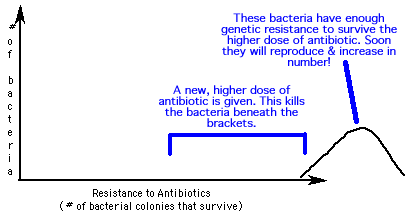
Natural Selection & the Development of Antibiotic Resistant Bacteria
An even higher dose of antibiotic is administered to the patient. This higher dosage kills many of the bacteria, but sometimes some of the highly resistant bacteria survive. If this happens, variation within the population will usually mean that some will be genetically less resistant, but others will be even more resistant.

If a new antibiotic is administered to the patient, many of these resistant bacteria will not have resistance to the new antibiotic, so they will die. Those that survive however, will have the ability to survive the new antibiotic. Thus, over time, antibiotics lose their ability to be effective to most bacterial pathogens.
Summary: "Bacterial populations show variation in resistance to antibiotics. When exposed to the antibiotic, only those with mutations allowing resistance survive. As the survivors reproduce, their young will show variation, but with slightly more with the resistance gene.
Again, only those that are resistant survive. Over many generations, the population gradually shifts so that most bacteria in the population have the resistance gene."